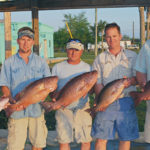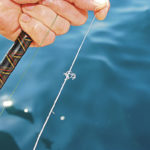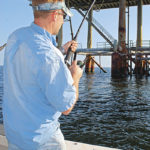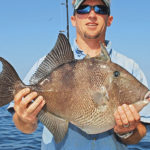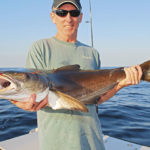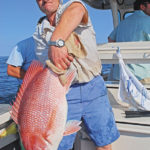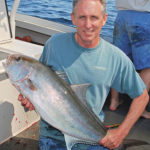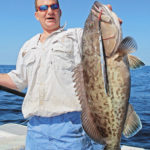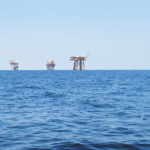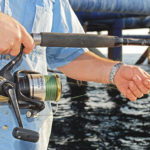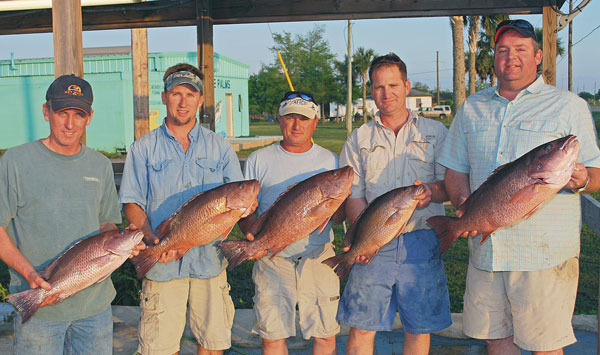
Use these techniques to have monster mangroves eating out of your hand.
The athletic young man’s glittering eyes and neatly trimmed goatee gave him the look of a predator. He was standing next to the boat that he had just won for catching the biggest mangrove snapper in the 2009 Coastal Conservation Association STAR Tournament.
The fish Brent Fay won the boat with was a 13.7-pound beast. If he had entered it in the Louisiana State Fish Records Program, it would have placed sixth on the all-time list. He didn’t; but he did enter it in the STAR Tournament, and won the boat.
While STAR Tournament director Sam Barbera zoomed in front of us, behind us and around us, putting the finishing touches on the awards program, Fay explained, almost nonchalantly, that he and his regular fishing partners routinely catch mangroves weighing over 10 pounds out of Venice.
“We sight-fish them,” the 38-year old said. “We toss bits of chum near offshore oil platform legs, and in the clear water you can see them come out to eat the chum. Then we toss a piece with a hook in it for them to eat.”
It seemed a lot more sporting than fishing for red snapper straight down, 150 or 200 feet deep, with a big hunk of lead on the end of your line. To me, that kind of fishing resembles dredging more than angling. So I hinted my interest to him.
Six months later I was in Venice to fish with Fay and his teammates, Kenny Morrison, Keith Haslauer and Joey Amedeo. Joining them to make a quintet for this trip was Amedeo’s cousin, Charles Hodgson. Our fishing platform was Morrison’s Reel Bad Habit, a gorgeous 31-foot custom-welded hull by Gaudet Aluminum Boats in Sorrento.
The four horsemen of this trip do catch a lot of mangrove snapper, but they are far from specialists.
“We try to take what the day will give us,” explained Morrison.
The men routinely chunk and live-bait drift for tuna, troll for wahoo, jig for grouper, live-bait fish for amberjack, rig fish for red snapper and never, ever turn their noses up at cobia.
Their fishing trips are always out of Venice because that is where Morrison stores the boat, fishing can be done on one side of the river or the other depending on wind conditions and because the Mississippi River delta has “some of the best fishing in the world.”
It had been a heck of a winter — cold, windy and wet. Spring was drier, but windier. But today, as the sleek boat popped out of Baptiste Collette Bayou into open waters, it appeared that the weather gods had smiled on us. The Gulf was almost slick calm.
Now it was up to the fishing gods.
Our destinations were the 12-mile rigs and the 24-mile rigs to the southeast of Baptiste Collette. The 12-mile rigs are 12 miles northeast of the mouth of South Pass and the 24-mile rigs are 12 miles farther. We planned to begin fishing at offshore oil and gas platforms in the 100-foot range and work our way deeper. Our first priority was to chum up some mangroves; then we would move to grouper and amberjack.
As Morrison eased the boat up to the first platform, it was easy to see that the water was a gorgeous bluish-green color, even in the poor light of early morning. Rather than hook to the rig, Morrison stayed at the helm and held the boat with its bow a few feet from the platform.
Haslauer immediately began to cut pogies into 1-inch slices and toss them near a rig leg. With Morrison holding the boat steady in the current by jockeying the twin 250-horsepower outboards, the other four men strained their eyes to see if any mangrove snappers ran out to grab the chum.
“Oh yeah, I see ‘em,” breathed Haslauer excitedly.
Immediately, Fay hooked up. Then Amedeo slammed the hook home, followed by a grunt from Haslauer as he connected. Fay’s and Haslauer’s fish were red snapper, which had to be returned to the water because the season was closed. Four of the men jeered sarcastically about the federal government’s position that red snapper are endangered.
But Amedeo’s voice wasn’t in the chorus. He was busy subduing a stubborn, near 11-pound mangrove. Every scale on the copper-colored beauty was outlined in pastel malachite.
One fish in the box.
Then — boom — two more quick hits. Amazingly enough, both were small gag groupers, caught only 5 feet from the surface in 95 feet of water. Fay looked puzzled.
“I’ve never chummed up gags before,” he said.
Morrison struggled a bit to hold the boat in place. The wind was blowing perpendicular to the water current. Fay explained that when the water current is running through the rig, they will hook onto the rig instead of trying to hold it in position with the motors. If water currents are very strong, sometimes, he said, they will have to hold the boat upcurrent of the rig and drift baits back into the rig.
The grouper were followed by a modest, but legal-sized, cobia and a bunch of red snapper. Deciding that they were just wasting bait chumming red snapper, the men decided to move to another platform.
As soon as the boat stopped at the next rig, Fay shouted “lemonfish!” The men stared into the water intently. Two rods with heavier lines were at ready, each baited with a whole pogie.
Nothing.
Morrison stepped from the helm, and with his hands beat a tattoo on the gunnel of the boat.
“It’s easy to make noise in an aluminum boat,” he grinned. “Lemonfish are curious fish. If you make noise, they’ll come up and check it out.”
“At least, so we are told,” added Fay mischievously.
After tossing in several pieces of chum, the men presented their baited hooks. All were using medium-heavy to heavy saltwater spinning reels, but none of them ever made a cast. Rather, each flipped the bail of his reel open and then tossed the chunk of bait with the hook in it with his free hand. Amedeo used an overhand throw, and the others pitched their baits underhanded.
Fay, who had taken over the job of being my tutor, explained what they were doing.
“You may have noticed that we completely buried every bit of the circle hook in the bait,” he said. “Mangrove snapper are incredibly wary, and if they see any part of a hook exposed, they won’t take the bait. That’s why we use what we call the ‘triangle,’ the hunk of the pogy right ahead of the tail. It hides the hook well.
“But if you cast the bait, the casting action will likely expose part of the hook, and the mangrove won’t take it. So don’t try to cast.
“Also, we like to use spinning reels because there is no restriction from the reel on the natural movement of the bait in the water. If you have the least tick on the line, they won’t touch it.”
The men use 5/0 to 7/0 circle hooks for the job. The main line of each reel is 50- to 70-pound-test Power Pro. They start with 10-foot fluorocarbon leaders in 30- to 80-pound test attached to the main line with a uni knot. Typically, the clearer the water is, the lighter the leader they use. As the day wears on and they lose hooks to sharks and other fish, their leaders become shorter, but they don’t usually change a leader until it is less than 4 or 5 feet long.
“If you can see fish down there and they’re not eating, generally your leader isn’t light enough or your hook is showing,” Fay said. “And sometimes even with light leaders, after you catch six or seven mangroves from a spot, they get smart. You can see them swarming down there. They take the chum, but they won’t take the one with the hook.
“They saw too many of their pals getting yanked out of there. Then all you can do is leave and go to another rig. That is pretty common.”
This rig proved to be as much of a red snapper magnet as the last one, producing at least 10 red ones for every mangrove, although it did yield a nice cobia. Every red snapper produced groans. Then sharks moved in. After the third one, one of the men muttered, “Yeah, sharks are supposed to be endangered just like red snapper.”
Another move was in order, this one to what the men called “the twin rigs,” located in 145 feet of water.
There the water was noticeably dingier. The stop produced plenty of action, but most of it was from pesky red snapper, although the rig produced yet another cobia.
After declaring the platform “corroded with red snapper,” the men gave up and moved to another one in 126 feet of water. The water was even worse than dingy; it was near dirty. But it produced a few mangroves. The problem that the men were having was still the nuisance of having to wrestle too many circle hooks out of red snapper mouths. At one point, three 12- to 15-pound red snapper were being unhooked at once.
Groaning and comical comments were becoming routine.
A zig back to the east brought the boat to the “city rigs,” a substantial cluster of platforms located in a little over 200 feet of water. The water was beautiful — almost oceanic blue.
More mangroves, some of them big ones and two super-sized gray triggerfish, the larger of which produced second looks by even these hardened offshore anglers. They joined the growing bounty of cobia and mangrove snapper in the ice chests. Then, Hodgson added a hard-fighting amberjack to the mix for variety.
“Looky here, looky here,” cooed Amedeo from the opposite side of the boat. A modest-sized scamp grouper floated on the water’s surface with a butterfly jig in its mouth. The catch changed the rest of the day. At every stop, someone was always pumping a vertical jig.
Haslauer scored next with a nice gag grouper, and then Fay added another scamp. The fishing gods had indeed smiled. The men’s huge ice chests were filling with beautiful reef fish. The cloudless sky, marked only by a solitary black smoke plume to the southwest, was crystalline blue, and the sea water was bluer.
The remainder of the afternoon was spent bouncing from rig to rig in the city rig cluster. At most of the platforms they were able to use a rig hook to tie to the platforms, freeing Morrison to fish as well.
The routine was the same at each stop. Some chum pieces would be tossed near a platform leg, and one or two men would stand ready to tease a bite from mangrove snapper. Fay or Haslauer, usually both, were armed with rods equipped with butterfly or the venerable but still effective diamond jigs. Occasionally, Morrison joined them, but mostly he and Hodgson concentrated on using cut bait.
The entertaining Amadeo, having satisfied his blood lust early, increasingly took on the role of the crew’s commentator and supervisor. His wisecracks were side-splitting.
More and more grouper joined the mangrove snapper and cobia in the ice chests, but all too soon, even the tireless fishing machines of Fay and Haslauer came to realize that the day was spent.
Morrison, Fay and Haslauer parked their bones on bean bag chairs while Amedeo swung the bow of the Reel Bad Habit to the northwest to head for home. On the port side of the boat, far off on the horizon, the tower of smoke I had seen earlier in the day had dissipated.
Fay settled into his nest, and after a pensive period, finally spoke.
“It’s amazing how many people you see out here who will pull up to a rig and drop deep for red snapper,” he said. “They don’t even know about the mangroves. They may catch one once in a while, while dropping down, but they really don’t know what’s here.”
Amedeo flicked the boat’s radio on. I heared some chatter about something called “Deepwater Horizon.” I didn’t make the connection with the smoke plume, and relaxed to enjoy the ride to Venice.
